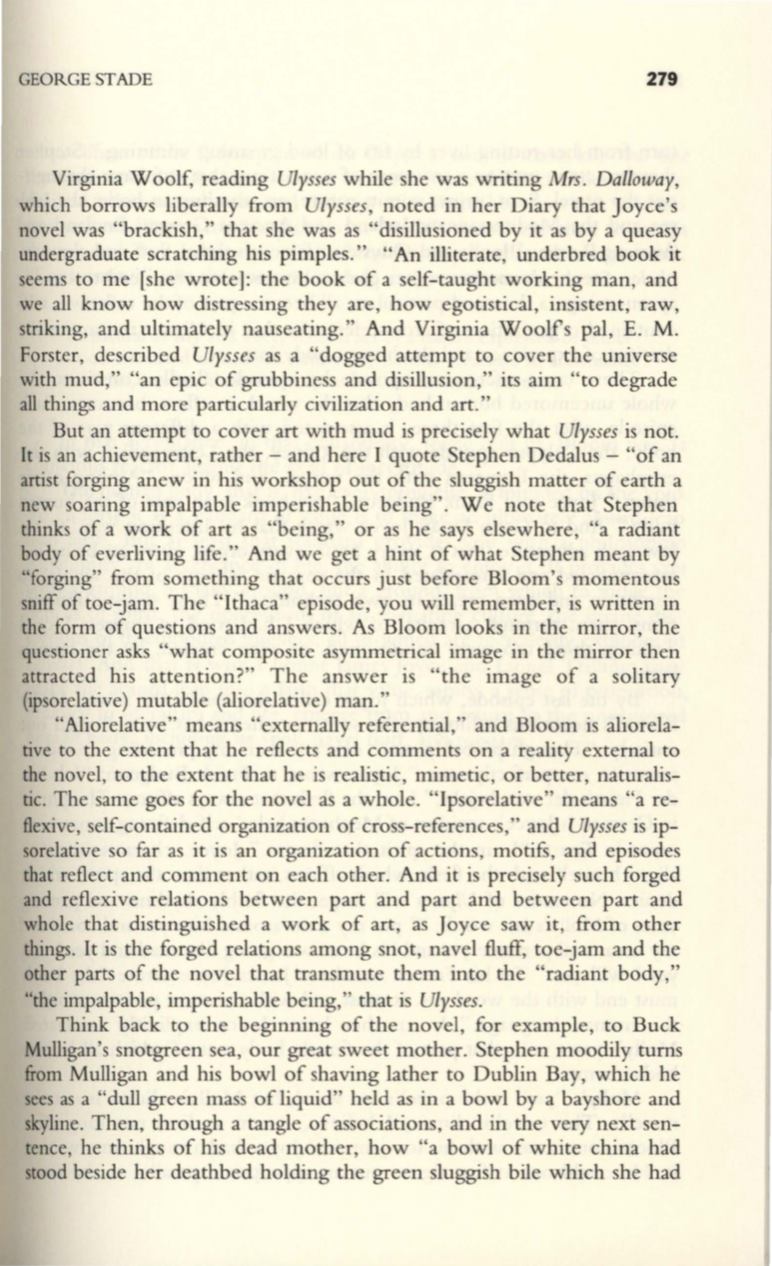
GEORGE STADE
279
Virginia Woolf, reading
Ulysses
while she was writing
Mrs. Dalloway,
which borrows liberally from
Ulysses,
noted in her Diary that Joyce's
novel was "brackish," that she was as "disillusioned by it as by a queasy
undergraduate scratching his pimples." "An illiterate, underbred book it
seems to me [she wrote]: the book of a self-taught working man, and
we all know how distressing they are, how egotistical, insistent, raw,
striking, and ultimately nauseating." And Virginia Woolfs pal, E. M.
Forster, described
Ulysses
as a "dogged attempt to cover the universe
with mud," "an epic of grubbiness and disillusion," its aim "to degrade
all things and more particularly civilization and art."
But an attempt to cover art with mud is precisely what
Ulysses
is not.
h is an achievement, rather - and here I quote Stephen Dedalus - "of an
artist forging anew in his workshop out of the sluggish matter of earth a
new soaring impalpable imperishable being" . We note that Stephen
thinks of a work of art as "being," or as he says elsewhere, "a radiant
body of everliving life." And we get a hint of what Stephen meant by
"forging" from something that occurs just before Bloom's momentous
sniff of toe-jam. The "Ithaca" episode, you will remember, is written in
the form of questions and answers. As Bloom looks in the mirror, the
questioner asks "what composite asymmetrical image in the mirror then
attracted his attention?" The answer is "the image of a solitary
(ipsorelative) mutable (aliorelative) man."
"Aliorelative" means "externally referential, " and Bloom is aliorela–
tive to the extent that he reflects and comments on a reality external to
the novel, to the extent that he is realistic, mimetic, or better, naturalis–
tic. The same goes for the novel as a whole. "Ipsorelative" means "a re–
flexive, self-contained organization of cross-references," and
Ulysses
is ip–
sorelative so far as it is an organization of actions, motifs, and episodes
that reflect and comment on each other. And it is precisely such forged
and reflexive relations between part and part and between part and
whole that distinguished a work of art, as Joyce saw it, from other
things.
It
is the forged relations among snot, navel fluff, toe-jam and the
other parts of the novel that transmute them into the "radiant body,"
"the impalpable, imperishable being," that is
Ulysses.
Think back to the beginning of the novel, for example, to Buck
Mulligan's snotgreen sea, our great sweet mother. Stephen moodily turns
from Mulligan and his bowl of shaving lather to Dublin Bay, which he
sees as a "dull green mass of liquid" held as in a bowl by a bayshore and
skyline. Then, through a tangle of associations, and in the very next sen–
tence, he thinks of his dead mother, how "a bowl of white china had
stood beside her deathbed holding the green sluggish bile which she had


